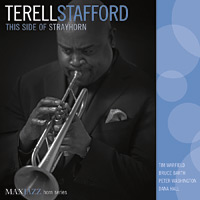Home » Jazz Articles » Album Review » Terell Stafford: This Side of Strayhorn
Terell Stafford: This Side of Strayhorn
Though more silently than it did in tumultuous 1970, this internal struggle rages on, and falling distinctly into the preservationist category is trumpeter Terell Stafford's This Side of Strayhorn—Billy Strayhorn, that is, the legendary composer/pianist/arranger to whom Stafford's album was conceived as an homage. As the man who spent a half-century serving as Duke Ellington's artistic foil, Strayhorn's pieces aren't merely timeless—they're the very cornerstones against which time is measured. American music, never mind jazz, is no less indebted to "Take The 'A' Train" than American politics are to the Revolutionary War—contained therein, in some form or another, are seeds from which all things after have sprouted.
It's fitting, then, that This Side of Strayhorn should play like the textbook exercise it is, plumbing the depths of the vintage Ellington aesthetic to extract the colors and emotions that render this music so instantly identifiable even after ninety years. These are Stafford's evocative flugelhorn passages in "My Little Brown Book," the rich tenor melancholia with which saxophonist Tim Warfield ushers in "Lush Life," and drummer Dana Hall's staggered accents throughout "Multicolored Blue," which also features a warbled sax intro worthy of Ben Webster himself. The remaining members of Stafford's quintet—pianist Bruce Barth and bassist Peter Washington—fight for space in the micro sense the same way Ellington's orchestra did in more grandiose fashion; they ricochet off Hall like Ellington and Jimmy Blanton off Sonny Greer.
As academic exercises often go, Stafford's isn't without its share of stiffness—much of the songbook is overly familiar, and the soloing is satisfying but safe. But like most tributes, this one's only half-academic. The other half consists of a certain vibrant joy that seems to emerge when a titan immerses himself at length in the work of his heroes, and by way of Stafford's earnest, irony-free genuflection, it's the compositions that have the last word. Even the most traditional artistic values in jazz were predated by directives exempt from academic scrutiny, and even Strayhorn's saddest ballads didn't betray them: Jazz, at its most fundamental, was supposed to be fun. And not even Wynton Marsalis himself can make that feel old-fashioned.
Track Listing
Raincheck; Smada; My Little Brown Book; Lush Life; Multicolored Hue; U.M.M.G. (Upper Manhattan Medical Group); Lana Turner; Day Dream; Johnny Come Lately.
Personnel
Terell Stafford
trumpetTerell Stafford: trumpet, flugelhorn; Tim Warfield: tenor and soprano saxophones; Bruce Barth: piano; Peter Washington: bass; Dana Hall: drums.
Album information
Title: This Side of Strayhorn | Year Released: 2011 | Record Label: MAXJAZZ
Comments
About Terell Stafford
Instrument: Trumpet
Related Articles | Concerts | Albums | Photos | Similar ToTags
Concerts
For the Love of Jazz
 All About Jazz has been a pillar of jazz since 1995, championing it as an art form and, more importantly, supporting the musicians who create it. Our enduring commitment has made "AAJ" one of the most culturally important websites of its kind, read by hundreds of thousands of fans, musicians and industry figures every month.
All About Jazz has been a pillar of jazz since 1995, championing it as an art form and, more importantly, supporting the musicians who create it. Our enduring commitment has made "AAJ" one of the most culturally important websites of its kind, read by hundreds of thousands of fans, musicians and industry figures every month.




















